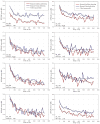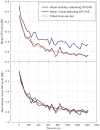Effects of cross-modal selective attention on the sensory periphery: cochlear sensitivity is altered by selective attention
- PMID: 22871520
- PMCID: PMC3471141
- DOI: 10.1016/j.neuroscience.2012.07.062
Effects of cross-modal selective attention on the sensory periphery: cochlear sensitivity is altered by selective attention
Abstract
There is increasing evidence that alterations in the focus of attention result in changes in neural responding at the most peripheral levels of the auditory system. To date, however, those studies have not ruled out differences in task demands or overall arousal in explaining differences in responding across intermodal attentional conditions. The present study sought to compare changes in the response of cochlear outer hair cells, employing distortion product otoacoustic emissions (DPOAEs), under different, balanced conditions of intermodal attention. DPOAEs were measured while the participants counted infrequent, brief exemplars of the DPOAE primary tones (auditory attending), and while counting visual targets, which were instances of Gabor gradient phase shifts (visual attending). Corroborating an earlier study from our laboratory, the results show that DPOAEs recorded in the auditory-ignoring condition were significantly higher in overall amplitude, compared with DPOAEs recorded while participants attended to the eliciting primaries; a finding in apparent contradiction with more central measures of intermodal attention. Also consistent with our previous findings, DPOAE rapid adaptation, believed to be mediated by the medial olivocochlear efferents (MOC), was unaffected by changes in intermodal attention. The present findings indicate that manipulations in the conditions of attention, through the corticofugal pathway, and its last relay to cochlear outer hair cells (OHCs), the MOC, alter cochlear sensitivity to sound. These data also suggest that the MOC influence on OHC sensitivity is composed of two independent processes, one of which is under attentional control.
Copyright © 2012 IBRO. Published by Elsevier Ltd. All rights reserved.
Figures




References
-
- Bassim MK, Miller RL, Buss E, Smith DW. Rapid adaptation of the cubic distortion tone emission in humans: Monaural, binaural and contralateral stimulation effects. Hear Res. 2003;182:140–152. - PubMed
-
- Brown M. Morphology and response properties of single olivocochlear fibers in the guinea pig. Hear Res. 1989;40(1–2):93–109. - PubMed
-
- Cody A, Johnstone B. Acoustically evoked activity of single efferent neurons in the guinea pig cochlea. J Acoust Soc Am. 1982;72:280–282. - PubMed
-
- Dai H, Scharf B, Buus S. Effective attenuation of signals in noise under focused attention. J Acoust Soc Am. 1991;89:2837–2842. - PubMed
Publication types
MeSH terms
Grants and funding
LinkOut - more resources
Full Text Sources

